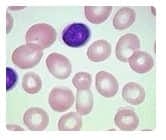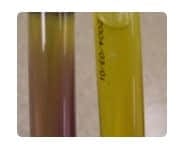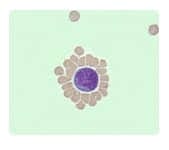Exam Details
Exam Code
:ASCP-MLTExam Name
:MEDICAL LABORATORY TECHNICIAN - MLT(ASCP)Certification
:ASCP CertificationsVendor
:ASCPTotal Questions
:572 Q&AsLast Updated
:Mar 21, 2025
ASCP ASCP Certifications ASCP-MLT Questions & Answers
-
Question 561:
Which of the following tests detect LTBI:
A. BAMT
B. culture
C. PCR
D. Two-step TST
-
Question 562:
Hemolytic anemia, myelodysplasia, and liver disease may each fit this peripheral blood picture. Each of these conditions can display peripheral blood macrocytosis. It is easy to observe the overall larger size of the red blood cells in this image
compared to the normal lymphocyte also present.
When macrocytes are present, they should be examined for their shape (round vs. oval), the hemoglobin content (central pallor), and whether or not there are any inclusions present in the cell.
Iron deficiency would not be the correct answer in this case, since this condition is associated with microcytosis instead.
The complete blood count was obtained from a patient recently admitted to the emergency room. The red blood cell indices obtained revealed an MCV of 115 femtoliters (fL) (normal range 80 - 90 fL). The patient met the criteria for a
peripheral blood smear examination. A representative field is shown on the right.

Which of the following conditions may be indicated by the results seen on this peripheral blood smear?
A. Hemolytic anemia
B. Myelodysplasia
C. Iron deficiency
D. Liver disease
-
Question 563:
Listeria monocytogenes is the correct answer. The motility agar is showing motility at the top of the tube, but not deeper; typical of this catalase-positive, gram positive bacillus. Streptococcus agalactiae would be catalase negative and a coccus. Erysipelothrix rhusiopathiae would be H2S-positive and catalase negative. Escherichia coli is a gram negative bacillus.

This Gram-positive bacillus grew as a diffusely beta-hemolytic colony from a newborn. It was catalase positive and had tumbling motility on a hanging drop preparation. This is how it appeared on triple sugar iron agar and motility medium. What is the most likely diagnosis?
A. Listeria monocytogenes
B. Streptococcus agalactiae
C. Erysipelothrix rhusiopathiae
D. Escherichia coli
-
Question 564:
The recommended disinfectant for blood and body fluid contamination is:
A. sodium hydroxide.
B. antimicrobial soap.
C. hydrogen peroxide.
D. sodium hypochlorite.
-
Question 565:
The image shown in this question is depicting a rosette formation. Here the red blood cells are surrounding and adhering to the outside of the white blood cell.

What is the best description of the phenomenon seen in this illustration?
A. Rouleau formation
B. Cold agglutination
C. Rosette formation
D. Monocyte activation
-
Question 566:
A laboratory scientist is working the night shift at a local hospital when the power goes out. What is the course of action to continue to provide laboratory results?
A. Wait until the power comes back
B. Hold all laboratory testing until the power comes back
C. Initiate the downtime protocol for an outage
D. Wait until the physician calls asking for results
-
Question 567:
Hybridization is a technique used to determine presence of target DNA or RNA by adding a synthetic strand that binds by complementary base pairing to the target.
Microbiology
In molecular diagnostic testing, hybridization employs complementary base pair binding of a synthetic strand to DNA or RNA.
A. true
B. false
-
Question 568:
Caffeine benzoate solution is used to split the unconjugated bilirubin protein complex releasing the bilirubin so that it can react with diazotised sulphanilic acid. The tartrate buffer creates an alkaline solution and converts the red acid bilirubin to a green coloured compound which can be measured spectrophotometrically.
Which substance is used in the Jendrassik-Grof method to accelerate the reaction of unconjugated bilirubin with the diazo reagent?
A. NADH
B. N-butanol
C. caffeine
D. acetic acid
-
Question 569:
Incompatiblity involving the ABO blood group system can cause the most severe type of transfusion reaction. The cause of the most severe life-threatening hemolytic transfusion reactions is:
A. Anti-D
B. Anti-M
C. Anti-A, Anti-B, Anti-A, B
D. Anti-Fya
-
Question 570:
Acute hemolytic transfusion reactions are most commonly due to ABO-incompatible blood being transfused to a recipient with naturally occurring ABO alloantibodies (anti-A, anti-B, anti A,B). Acute intravascular hemolysis as the result of a blood transfusion is most often associated with which of the following causes?
A. Transfusion of ABO incompatible red cells
B. Allergies
C. Passively transfused antibodies to HLA antigens
D. Transfusion-associated graft-versus-host disease
Related Exams:
Tips on How to Prepare for the Exams
Nowadays, the certification exams become more and more important and required by more and more enterprises when applying for a job. But how to prepare for the exam effectively? How to prepare for the exam in a short time with less efforts? How to get a ideal result and how to find the most reliable resources? Here on Vcedump.com, you will find all the answers. Vcedump.com provide not only ASCP exam questions, answers and explanations but also complete assistance on your exam preparation and certification application. If you are confused on your ASCP-MLT exam preparations and ASCP certification application, do not hesitate to visit our Vcedump.com to find your solutions here.